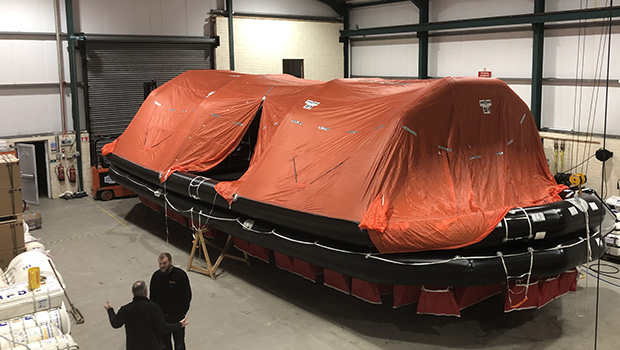Blog Post
How Often Are Life Raft Inspections Required? [IMO + SOLAS Explained]
Posted By: Harsh Bamnolia
Posted On : 23-Aug-2025

How Often Are Life Raft Inspections Required? [IMO + SOLAS Explained]
Life raft inspection requirements are not just a matter of routine maintenance—they are a legal and safety necessity.
If you operate a commercial vessel, offshore platform, or even a leisure yacht, ensuring your liferafts are inspected and serviced according to life raft inspection requirements defined by SOLAS and IMO regulations can make the difference between safety and catastrophe at sea.
In this comprehensive guide, we’ll walk you through the exact life raft inspection requirements as set by international maritime law, the types of inspections required, the inspection schedule, and what happens during the process.
Understanding Life Raft Inspection Requirements under SOLAS & IMO
The life raft inspection requirements are primarily governed by two major authorities:
SOLAS (International Convention for the Safety of Life at Sea)
IMO (International Maritime Organization)
According to SOLAS Chapter III – Life-Saving Appliances and Arrangements – all liferafts carried on seagoing vessels must be inspected and serviced at least once every 12 months by an authorized service station.
IMO resolutions like MSC.48(66) and MSC.81(70) provide additional guidelines on testing and maintenance procedures, ensuring that equipment functions reliably in emergencies.
This means your compliance with life raft inspection requirements is essential to meet global safety standards and to avoid penalties during Port State Control (PSC) inspections.
What Is the Frequency of Life Raft Inspections?
Let’s break down the life raft inspection requirements into time-based intervals:
Annual Inspection (Mandatory)
Every liferaft must undergo a full inspection at an authorized service station at least once every 12 months, regardless of use.Intermediate Inspection (Optional/Condition-Based)
While not mandatory under SOLAS, shipowners often schedule a mid-year check to ensure the equipment hasn't degraded.After Deployment or Damage
If the liferaft has been accidentally deployed or exposed to environmental hazards (e.g., fire, flooding, collision), it must be re-inspected—even if the last inspection was recent.Extended Servicing Intervals (Under Special Approval)
In certain conditions, where liferafts are not used frequently (such as on oil rigs or ferries), some administrations allow a 30-month servicing interval. However, this is conditional and must follow IMO Circ.1328 guidelines.
Remember, no matter the schedule, life raft inspection requirements emphasize inspection by certified technicians at approved facilities.
What Happens During a Life Raft Inspection?
A standard life raft inspection follows a checklist that ensures the safety, usability, and regulatory compliance of the equipment. Here's what certified technicians usually do:
Visual Inspection of Container and Markings
Any dents, cracks, or wear are documented. Expiry dates are verified.Inflation Test
The raft is inflated to its working pressure, typically in a temperature-controlled environment, and checked for leaks.Testing of Inflation System
Cylinders and valves are examined for pressure levels and condition.Inspection of Emergency Pack
Items like food rations, water, flares, whistles, and thermal blankets are checked and replaced if expired.Review of Buoyancy Chambers
Ensures no punctures, deformation, or delamination of fabric.Pressure Relief Valves Test
Prevents overinflation that can rupture the raft during deployment.Hydrostatic Release Unit (HRU) Check
Mandatory under life raft inspection requirements to ensure auto-release in case of sinking.Cleaning & Repacking
The raft is cleaned, dried, and repacked per manufacturer specifications.Documentation Issuance
An inspection certificate, checklist, and service tag are issued, proving compliance with life raft inspection requirements.
Key Documents and Records to Maintain
After every servicing, you should retain:
Inspection Certificate (signed & stamped)
Service Checklist
Photos of Condition (if available)
Record of Replaced Parts
Expiry Dates of Emergency Items
Updated Liferaft Register/Logbook
Missing documentation is a red flag during maritime audits. According to life raft inspection requirements, proof of compliance must be available for authorities upon request.
Why Ignoring Inspection Can Be Dangerous (and Expensive)
Neglecting life raft inspection requirements can lead to:
Heavy fines during Port State Control inspections
Vessel detention due to safety non-compliance
Insurance claims being denied in emergencies
Lives endangered due to malfunctioning equipment
In 2021 alone, over 25% of PSC deficiencies in Asia-Pacific were related to life-saving appliances—emphasizing the global importance of adhering to life raft inspection requirements.
Who Can Perform a Life Raft Inspection?
Only authorized service stations approved by your flag state and the equipment manufacturer can legally conduct inspections. These stations must be equipped with:
Controlled environment for testing
Manufacturer-trained technicians
Spare parts inventory
Up-to-date licenses & compliance documentation
Using unauthorized vendors may void warranties and violate life raft inspection requirements, putting your vessel at legal and operational risk.
Quick Checklist: Are You Compliant?
Use the following checklist to evaluate your compliance with life raft inspection requirements:
? Is the last inspection date within the last 12 months?
? Was the inspection done at an authorized station?
? Are the certificates updated and onboard?
? Are all emergency pack items within expiry?
? Has the HRU been replaced (usually every 2 years)?
? Are the logs and records maintained properly?
If you answered “No” to any of these, your vessel is at risk. Schedule an inspection immediately.
Tips to Stay Ahead of Inspection Deadlines
Set Annual Reminders for each raft on your fleet.
Bundle Safety Equipment Servicing (e.g., lifejackets, HRUs) together to save on costs and logistics.
Use a Service Provider with Pan-India Reach so your vessel can dock at any port and still receive timely servicing.
Label Each Liferaft Clearly with inspection due dates for crew awareness.
Conclusion
Adhering to life raft inspection requirements is not just about compliance—it’s about protecting lives, assets, and reputation. As regulations become more stringent and audits more frequent, staying on top of your inspection schedule is essential.
Need expert guidance on life raft inspections in India?
Ensure your fleet stays safe and compliant by partnering with certified marine safety providers. Book your next inspection with a DG Shipping-approved center today.